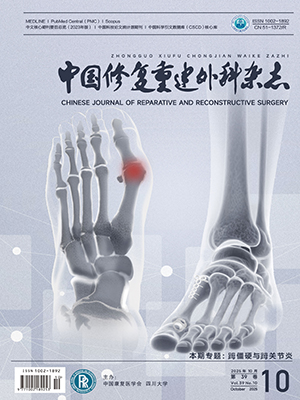| 1. |
Le HV, Javidan Y, Khan SN, et al. Dysphagia after anterior cervical spine surgery: pathophysiology, diagnosis, and management. J Am Acad Orthop Surg, 2024, 32(14): 627-636.
|
| 2. |
Colón LF, Barber L, Soffin E, et al. Management and treatment algorithm of airway complications after anterior cervical spine surgery: systematic review. J Spine Surg, 2024, 10(3): 562-575.
|
| 3. |
Chen T, Wang Y, Zhou H, et al. Comparison of anterior cervical discectomy and fusion versus anterior cervical corpectomy and fusion in the treatment of localized ossification of the posterior longitudinal ligament. J Orthop Surg (Hong Kong), 2023, 31(1): 10225536231167704. doi: 10.1177/10225536231167704.
|
| 4. |
Yu H, Li X, Chen S, et al. Comparative effectiveness and safety of anterior cervical corpectomy with fusion, laminoplasty, and laminectomy and instrumented fusion for ossification of the posterior longitudinal ligament: a systematic review and network meta-analysis. J Invest Surg, 2022, 35(3): 667-676.
|
| 5. |
宋仁谦, 周英杰, 郑怀亮, 等. 颈椎前路V形截骨Y形减压融合术治疗后纵韧带骨化症的临床疗效观察. 中国脊柱脊髓杂志, 2024, 34(5): 449-457.
|
| 6. |
田杨, 韩永正, 李娇, 等. 颈椎前路手术后硬膜外血肿的发生率和危险因素. 北京大学学报(医学版), 2024, 56(6): 1058-1064.
|
| 7. |
曹国龙, 陈卓, 施集, 等. 颈椎前路椎体次全切除植骨融合术后钛网沉降的危险因素. 中国脊柱脊髓杂志, 2023, 33(7): 602-609.
|
| 8. |
李玉伟, 严晓云, 潘传红, 等. 超声骨刀系统行椎板切除、后纵韧带骨化块切断联合去后凸矫形治疗多节段胸椎后纵韧带骨化症. 中国修复重建外科杂志, 2024, 38(9): 1086-1091.
|
| 9. |
Sun K, Zhang S, Yang B, et al. The effect of laminectomy with instrumented fusion carried into the thoracic spine on the sagittal imbalance in patients with multilevel ossification of the posterior longitudinal ligament. Orthop Surg, 2021, 13(8): 2280-2288.
|
| 10. |
Ando K, Nakashima H, Machino M, et al. Postoperative progression of ligamentum flavum ossification after posterior instrumented surgery for thoracic posterior longitudinal ligament ossification: long-term outcomes during a minimum 10-year follow-up. J Neurosurg Spine, 2021, 36(6): 986-996.
|
| 11. |
Oshina M, Oshima Y, Tanaka S, et al. Radiological fusion criteria of postoperative anterior cervical discectomy and fusion: a systematic review. Global Spine J, 2018, 8(7): 739-750.
|
| 12. |
王海波, 李欣, 王子然, 等. 颈椎前路椎体可控前移融合术和颈椎前路椎体次全切除融合术治疗多节段脊髓型颈椎病伴椎管狭窄的短期疗效. 脊柱外科杂志, 2024, 22(4): 222-227.
|
| 13. |
Lee CY, Chen PC, Wu MH, et al. Minimally invasive surgical treatment of extensive spinal epidural abscess with unilateral laminotomy for bilateral decompression using an ultrasonic bone curette: a technique note. World Neurosurg, 2022, 168: 111-119.
|
| 14. |
Renjith KR, Eamani NK, Raja DC, et al. Ultrasonic bone scalpel in spine surgery. J Orthop, 2023, 41: 1-7.
|
| 15. |
Steinle AM, Chen JW, O’Brien A, et al. Efficacy and safety of the ultrasonic bone scalpel in lumbar laminectomies. Spine Surg Relat Res, 2022, 7(3): 242-248.
|
| 16. |
Moon RDC, Srikandarajah N, Clark S, et al. Primary lumbar decompression using ultrasonic bone curette compared to conventional technique. Br J Neurosurg, 2021, 35(6): 775-779.
|
| 17. |
徐陈, 王照东, 刘亚军, 等. 超声骨刀在颈椎前路手术中的应用研究. 中国修复重建外科杂志, 2023, 37(8): 996-1001.
|
| 18. |
Kim CH, Renaldo N, Chung CK, et al. Use of an ultrasonic osteotome for direct removal of beak-type ossification of posterior longitudinal ligament in the thoracic spine. J Korean Neurosurg Soc, 2015, 58(6): 571-577.
|
| 19. |
鲍小明, 张小平, 郭卫东, 等. 显微镜辅助下超声骨刀在颈椎前路骨化物切除中的应用及临床疗效. 生物骨科材料与临床研究, 2023, 20(6): 27-31.
|




